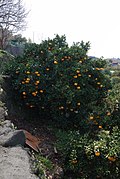Amanatsu
| Amanatsu/Kawano natsu daidai | |
|---|---|

| |
| Scientific classification | |
| Kingdom: | Plantae |
| Clade: | Tracheophytes |
| Clade: | Angiosperms |
| Clade: | Eudicots |
| Clade: | Rosids |
| Order: | Sapindales |
| Family: | Rutaceae |
| Genus: | Citrus |
| Species: | C. × natsudaidai
|
| Binomial name | |
| Citrus × natsudaidai | |
Amanatsu (
Names
[edit]Amanatsu (
Description
[edit]Natsumikan is about the size of grapefruit and oblate in shape. The fruit contains 12 segments and about 30 seeds. The rough textured fruit is easy to peel and is commonly eaten fresh. It is also used for wide variety of products ranging from marmalades to alcoholic beverages.[citation needed]
Cultivation
[edit]Natsumikan is grown commercially in Japan, notably in Yamaguchi, Kumamoto and Ehime prefecture. The city of Hagi is famous for its natsumikans, particularly when used in natsumikan juice and ice cream.[citation needed]
Yamaguchi Prefecture takes such pride in their natsumikan industry that the typically white crash barriers of Japan were changed to a befitting orange.[citation needed]
Genetics
[edit]The natsumikan tree is believed to be genetically derived from the pomelo (Citrus grandis or Citrus maxima).[citation needed]
Medicine
[edit]Researchers found that immature natsumikan peel is beneficial for the treatment of chronic allergic dermatitis in mice.[2]
Gallery
[edit]-
The large bearing tree.
-
Locally at Nagato, Yamaguchi.
-
At street side in Hagi, Yamaguchi.
-
Blossoms.
-
On tree.
-
Fruit.
See also
[edit]References
[edit]- ^ ナツミカン (in Japanese). Kotobank. Archived from the original on 6 October 2022. Retrieved 23 May 2023.
- ^ Nakayama, N; Yamaura, K; Shimada, M; Ueno, K (2011). "Extract from peel of Citrus natsudaidai alleviates experimental chronic allergic dermatitis in mice". Pharmacognosy Research. 3 (3): 155–9. doi:10.4103/0974-8490.84999. PMC 3193614. PMID 22022162.
Further reading
[edit]- Natsudaidai Archived 2019-04-25 at the Wayback Machine at the Citrus Variety Collection







